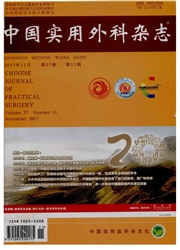

 中文摘要:
中文摘要:
目的探讨急性胰腺炎(AP)后期(发病2周后)发生感染性胰腺坏死(IPN)的影响因素。方法回顾性分析2012年1月至2014年7月南京军区南京总医院普通外科收治的153例AP病人临床资料。根据病人后期是否出现IPN分为非感染组(123例)和感染组(30例),比较两组病人临床特征及实验室检查指标,并分析AP后期发生IPN的影响因素。结果感染组病人的急性生理与慢性健康系统(APACHEⅡ)评分、血小板计数、C反应蛋白、淋巴细胞计数、淋巴细胞比例、中性粒细胞与淋巴细胞计数比值、白蛋白、单核细胞人类白细胞抗原DR与非感染组之间差异有统计学意义(P〈0.05);多因素回归分析结果显示,APACHEⅡ评分和淋巴细胞计数是AP后期发生IPN的独立影响因素。淋巴细胞计数预测IPN的临界值为0.7×109/L,敏感度为83.7%,特异度为66.2%。结论淋巴细胞计数和APACHEⅡ评分为AP后期发生IPN的独立危险因素,其中早期监测淋巴细胞计数可能成为预测AP病人后期发生IPN的有效方法。
 英文摘要:
英文摘要:
Objective To investigate influence factors of the development of infected pancreatic necrosis (IPN) in the later course of pancreatitis. Methods The clinical data of 153 patients with acute pancreatitis admitted from January 2012 to July 2014 in Department of General Surgery, Nanjing General Hospital of Nanjing Military Command of PLA were analyzed retrospectively. The patients were divided into two groups according to the presence of infection pancreatic necrosis (IPN): non-infection (n=123) and infection (n=30) group. The clinical characteristics and laboratory parameters were measured on admission and compared between the two groups. Logistic regression model was constructed to predict the possible risk factors for IPN. Results Univariate logistic regression analysis suggested that there was significant difference in APACHE Ⅱ score, platelet, C-reactive protein, absolute lymphocyte count, lymphocyte proportion, neutrophil-lymphocyte ratio (NLR), albumin as well as HLA-DR between two groups (P〈0.05). Multivariate logistic regression analysis indicated that APACHE Ⅱ score and absolute lymphocyte count were independent predictors for IPN. The critical value of lymphocyte proportion for predictry IPN was 0.7×109/L, sensitinty was 83.79%, and sptificity was 66.7%. Conclusion Monitoring the absolute lymphocyte count in the early phase of acute pancreatitis may be an effective way to predict the possibility of IPN in the later course of pancreatitis.
 同期刊论文项目
同期刊论文项目
 同项目期刊论文
同项目期刊论文
 Risk Factors and Outcome for Massive Intra-Abdominal Bleeding Among Patients With Infected Necrotizi
Risk Factors and Outcome for Massive Intra-Abdominal Bleeding Among Patients With Infected Necrotizi Codonopsispilosula polysaccharide attenuates cecal ligation and puncture sepsis via circuiting regul
Codonopsispilosula polysaccharide attenuates cecal ligation and puncture sepsis via circuiting regul Codonopsis pilosula Polysaccharide Attenuates Cecal Ligation and Puncture Sepsis via Circuiting Regu
Codonopsis pilosula Polysaccharide Attenuates Cecal Ligation and Puncture Sepsis via Circuiting Regu Nicotine ameliorates experimental severe acute pancreatitis via enhancing immunoregulation of CD4+ C
Nicotine ameliorates experimental severe acute pancreatitis via enhancing immunoregulation of CD4+ C The importance of timing of decompression in severe acute pancreatitis combined with abdominal compa
The importance of timing of decompression in severe acute pancreatitis combined with abdominal compa 期刊信息
期刊信息
